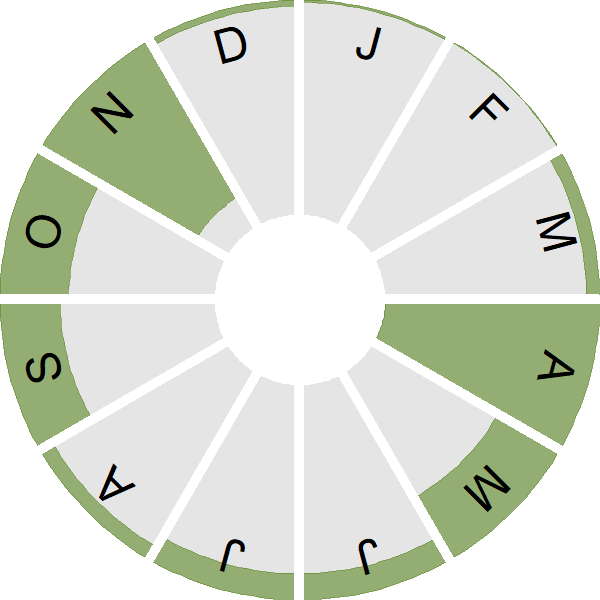Hoopoe

Introduction
Unmistakable, with its down-curved bill, black, white and sandy brown plumage – not to mention its crest – this is a striking visitor to our shores, most often encountered in spring but with records from all months.
With a wide breeding range, extending from Portugal in the west to China in the east, the Hoopoe breeds as far north as Estonia.
Occasional pairs have bred here in Britain, although we lack the abundance of grasshoppers, crickets and small lizards that are the favoured prey within its core breeding range.

Key Stats
Identification
Songs and Calls
Song:
Status and Trends
Conservation Status
Population Size
Population Change
Hoopoe is an occasional breeder in the UK. Although singing males are recorded most years, the last breeding record was by a pair in Wales in 1996 [Ogilvie & the Rare Breeding Birds Panel 1999]. This was the first breeding record since 1977 when four pairs bred at different locations in southern England [Batten et al 1979]. Migrant Hoopoes are seen regularly on spring and autumn passage, with the highest numbers observed in April and September; although sightings are spread across the UK, the majority of records are concentrated in southwest England [White & Kehoe 2024]. The latest report on scarce migrant birds [White & Kehoe 2024] notes a couple of individuals that overwintered in the UK during winter 2021/22.
Distribution
During Bird Atlas 2007–11 there were non-breeding records of Hoopoes in 203 10-km squares in Britain and a further nine squares in Ireland. These were typically spring-migration overshoots and their distribution fits the established pattern. Breeding was last confirmed in 1996.
Occupied 10-km squares in UK
or view it on Bird Atlas Mapstore.
or view it on Bird Atlas Mapstore.
European Distribution Map
Distribution Change
Change in occupied 10-km squares in the UK
or view it on Bird Atlas Mapstore.
or view it on Bird Atlas Mapstore.
Seasonality
Hoopoes are scarce migrants that can be recorded from early spring onwards with some birds present in autumn and occasionally in winter.
Weekly pattern of occurrence
The graph shows when the species is present in the UK, with taller bars indicating a higher likelihood of encountering the species in appropriate regions and habitats.

Movement
Britain & Ireland movement
Foreign locations of birds ringed or recovered in Britain & Ireland
Dots show the foreign destinations of birds ringed in Britain & Ireland, and the origins of birds ringed overseas that were subsequently recaptured, resighted or found dead in Britain & Ireland. Dot colours indicate the time of year that the species was present at the location.
- Winter (Nov-Feb)
- Spring (Mar-Apr)
- Summer (May-Jul)
- Autumn (Aug-Oct)

European movements
EuroBirdPortal uses birdwatcher's records, such as those logged in BirdTrack to map the flows of birds as they arrive and depart Europe. See maps for this species here.
The Eurasian-African Migration Atlas shows movements of individual birds ringed or recovered in Europe. See maps for this species here.
Biology
Productivity and Nesting
Nesting timing
Egg measurements
Clutch Size
Survival and Longevity
Survival is shown as the proportion of birds surviving from one year to the next and is derived from bird ringing data. It can also be used to estimate how long birds typically live.
View number ringed each year in the Online Ringing Report.
Survival of adults
Biometrics
Wing length and body weights are from live birds (source).
Ring Size
Classification, names and codes
Classification and Codes
- Order: Bucerotiformes
- Family: Upupidae
- Scientific name: Upupa epops
- Authority: Linnaeus, 1758
- BTO 2-letter code: HP
- BTO 5-letter code: HOOPO
- Euring code number: 8460
Alternate species names
- Catalan: puput comuna
- Czech: dudek chocholatý
- Danish: Hærfugl
- Dutch: Hop
- Estonian: vaenukägu e. toonetutt
- Finnish: harjalintu
- French: Huppe fasciée
- Gaelic: Calman-cathaidh
- German: Wiedehopf
- Hungarian: búbosbanka
- Icelandic: Herfugl
- Irish: Húpú
- Italian: Upupa
- Latvian: pupukis, bada dzeguze
- Lithuanian: kukutis
- Norwegian: Hærfugl
- Polish: dudek
- Portuguese: poupa / poupa-eurasiática
- Slovak: dudok chochlatý
- Slovenian: smrdokavra
- Spanish: Abubilla común
- Swedish: härfågel
- Welsh: Copog

